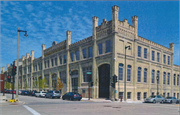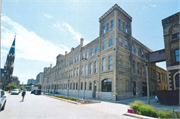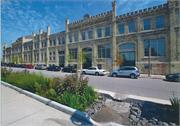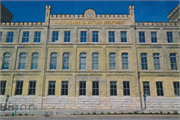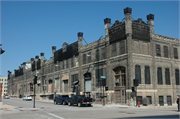| Additional Information: | A 'site file' exists for this property named 'Pabst Brewing Company'. It contains additional information such as correspondence, newspaper clippings, or historical information. It is a public record and may be viewed in person at the Wisconsin Historical Society, State Historic Preservation Office.
Part of Pabst Brewery Complex. Locally designated in 1985.
2001- "The Pabst Brewery consists of 25 buildings located on four blocks that are focused around the intersection of W. Juneau Avenue and N. 1Oth Street. This complex was locally designated by the City of Milwaukee on July 30, 1985 as the Pabst Brewing Company Historic District. Constructed between 1870 and 1969, the buildings range from three to eight stories in height and exhibit various masonry materials, including cream brick, pressed brick, cut stone and concrete. Although many of these utilitarian buildings lack high-style architectural elements, certain features such as crenellated parapets, arcaded corbeling and arched window openings, are repeated throughout the complex. In addition, the group of buildings that is located on the southwest corner of N. 9th Street and W. Juneau Avenue includes the visitor's center and brewery offices, which are excellent examples of the German Renaissance Revival style. Notable architects such as Otto Strack and Charles Hoffman have designed buildings or building additions within the complex. Specific construction dates and the function of individual buildings are noted on the survey cards that accompany this report.
The brewery that ultimately would bear the Pabst name was founded by Jacob Best, Sr. in 1844. Having immigrated from Mettenheim, Germany, Best started the Best and Company Brewery, which became one of the first in Milwaukee to produce lager beer. Phillip Best, Jacob's son, took over the operation in 1853 and later changed its name to the Phillip Best Brewing Company. Under Phillip's leadership, the brewery prospered and his two sons-in-law joined the business. One of them was Captain Frederick Pabst. Having formerly served as a Lake Michigan steamship captain, Pabst became the brewery's president in 1866, following the retirement of his father-in-law. The brewery continued to do well, becoming Milwaukee's largest in 1868. With the purchase of an additional brewery in the Menomonee Valley, it became the nation's largest in 1874-a distinction it would hold until 1946. A fire in 1879 destroyed many of the brewery buildings on Juneau Avenue, and the Menomonee Valley facility temporarily was required to accommodate most of the production. By 1886 however, all operations were transferred back to the subject facility and use of the Menomonee Valley site was discontinued. During this period, the brewery experienced its largest physical expansion and, in 1889, the business was renamed the Pabst Brewing Company. Captain Pabst shrewdly marketed his beer. By developing a restaurant and hotel chain, he ensured a network of establishments that would distribute his product nationally. His beer also prospered from the notoriety it received after being judged the best at the 1893 World's Columbian Exposition in Chicago; Pabst capitalized on this, creating the now famous "Blue Ribbon" label. When Captain Pabst died in 1904, he left behind a thriving company that would be run by his son, Gustav. After successfully surviving Prohibition, the company started to decline in the post-World War II era. Although it re-emerged during the 1960s and 1970s as the nation's third largest brewery, it was sold in 1985 and eventually closed in 1996."
- "Marquette Interchange, Milwaukee", WisDOT ID #1060-05-02, Prepared by Heritage Research (McQuillen) (2001). |
|---|

